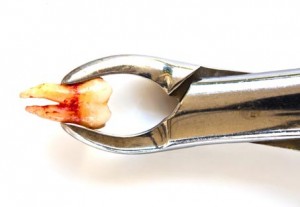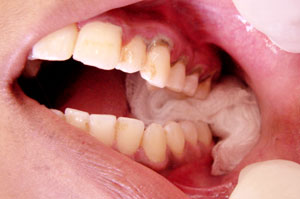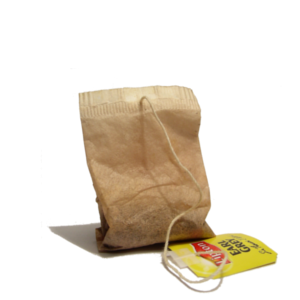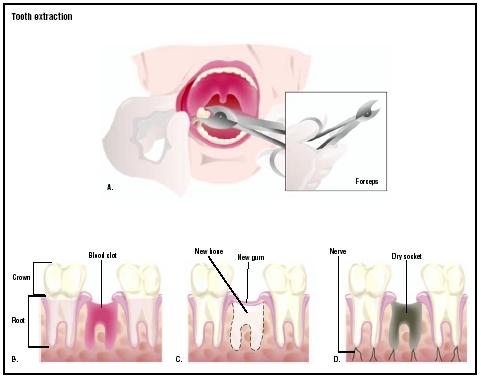Tooth extractions can be a bloody affair. Bleeding or the abnormal flow of blood is normally seen in tooth extraction but excessive bleeding can be caused by something as simple as taking aspirin to prevent heart attacks or because of some inherited blood disorders.
Bleeding presents as a severe challenge to the mechanism that stops bleeding as:
- Tissues in the mouth and jaws are highly blood-supplied.
- Dental tooth extraction leaves an open wound (in both hard and soft tissues) which allows additional ooze and bleeding.
- People who move their tongue over the surgical area can dislodge the blood clot formed and result in bleeding.
- Enzymes in the saliva can disintegrate the blood clot before it gets organized.
Bleeding or hemorrhage can be classified under the following:
- Primary hemorrhage – bleeding that happens during extraction or surgery
- Reactionary hemorrhage – bleeding within a few hours after extraction or surgery due to the cessation of vasoconstrictor drug of damaged vessels
- Secondary hemorrhage – bleeding after two weeks post-extraction due to infection
How to control bleeding from tooth extraction or oral surgery
Before tooth extraction or oral surgery
A detailed medical history should be given to the dentist, which includes:
- Incidence of prolonged bleeding
- Previous injuries, surgeries, history of nose bleeding, easy bruising
- Family history of bleeding
- Habits, for example smoking which can damage the liver and decrease the clotting factors within it
- Medications such as anticoagulants (for example Warfarin) and anticancer chemotherapy
- Diseases that cause excessive bleeding, for example hemophilia, Von Willibrand’s disease, and thrombocytopenic purpura
Investigations of a bleeding disorder should be done prior to teeth extraction.
During tooth extraction or oral surgery
Excess bleeding can occur even in the absence of bleeding disorders.
To prevent excessive bleeding,
- Extraction or surgery should be non-traumatic surgery
- Clean incisions should be made
- Gentle management of tissues
- Soft tissues should not be crushed
- All granulation tissues (if found) should be removed
The bleeding source should be checked – whether it is from bone or soft tissues. The common way to stop bleeding is to apply firm pressure with gauze for 5 to 10 minutes.
If bleeding persists from soft tissues even after firm pressure, then:
- Injection of local anesthesia with adrenaline acts as a vasocontrictor
- Gelfoam forms a scaffold for formation of clot
- Regenerated oxidized cellulose forms a scaffold for formation of clot
- Topical thrombin converts fibrinogen to fibrin
- Collagen plug promotes platelet aggregation
If a single blood vessel is found to be the cause:
- The artery is identified, clamped and tied with a suture
- Coagulate with diathermy (clotting the opening of the blood vessel with heat)
When persistent ooze comes from bone, bone wax is applied.
If all these measures fail:
- The socket is packed with Whitehead’s varnish (compound iodoform paint) that should be removed 10 days later.
- The extraction or surgical site is sutured.
After tooth extraction or oral surgery
Usually immediately after dental extraction the dentist will place a small piece of gauze over the extraction socket and instruct you to bite firmly for at least 30 minutes. If the bleeding persists, replace the gauze piece with a new one or you can use ordinary black tea as it contains tannic acid, which is very effective in forming blood clots. Wet a teabag, squeeze out excess water, put it over the extraction area and bite firmly again for another 30 minutes. Repeat till bleeding stops.
During this period, try to minimize talking for three to four hours. There will be slight oozing for 24 hours which is normal but do be reminded that most of it is saliva.
Avoid rinsing your mouth vigorously, drinking with straw, and spitting for 12 hours for these activities could lead to a disruption of the formation of a blood clot in the mouth and generate negative pressure that can dislodge the blood clot which has formed in the tooth socket and promote bleeding. Also avoid strenuous activities for a day.
Smoking should be avoided for a minimum of 24 hours for cigarette smoke is hot and will cause the blood vessels to dilate, restarting or prolonging bleeding. Smoking can also cause a painful “dry socket†about three days after the extraction.
Hot liquids such as coffee, tea or hot soup can also dissolve blood clots. Displaced or dissolved blood clots can lead to the formation of a dry socket.
On the day of extraction, brush the teeth that are away from the area of extraction, and avoid brushing the teeth immediately adjacent to the extraction site. For the first 24 hours avoid gargling.
Next day gentle rinses with warm water or salt water can be done. Normal tooth brushing can be resumed on the 3rd or 4th day.
If you experience prolonged bleeding, bright red bleeding and/or large blood clots, return to the dentist for further management.
If systemic cause is suspected or bleeding is not controllable by all these measures then the dentist will refer you to a specialist.



